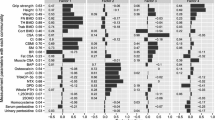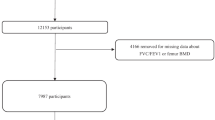Abstract
The association between respiratory function and bone mineral density (BMD) among women living in the community has been reported previously. We examined the association between forced expiratory volume in 1 s (FEV1) and BMD measured at hip using dual-energy X-ray absorptiometry in a group of 947 men (aged 65 to 76 years) recruited from general practice age-sex registers in Cambridge between 1991 and 1995. A positive and significant correlation was seen between FEV1 and BMD measured at total hip, femoral neck, and trochanter. A unit change (1 l) in FEV1 was associated with a change of BMD by 0.019, 0.017, and 0.026 g/cm2 in the total hip, femoral neck, and tochanteric region, respectively. These associations were independent of possible confounding factors such as age, height, weight, smoking habit, major disease prevalence, and medications, which might affect bone metabolism. In categorical analyses, the highest BMD was seen in the highest FEV1 quartile, while the lowest BMD was seen in the lowest FEV1 quartile. This pattern was seen in all three skeletal sites and was independent of covariates listed above. Compared with the bottom FEV1 quartile, mean hip BMDs in the top quartile were 2–3.5% higher. The exact mechanism of this association is not clear to us. One plausible explanation is that respiratory function and bone health both reflect common but as yet unknown determinants.
Similar content being viewed by others
References
Elkin SL, Fairney A, Burnett S et al (2001) Vertebral deformities and low bone mineral density in adults with cystic fibrosis: a cross-sectional study. Osteoporos Int 12:366–372
Sin DD, Man JP, Man SF (2003) The risk of osteoporosis in Caucasian men and women with obstructive airway disease. Am J Med 114:10–14
Lekamwasam S, Trivedi DP, Khaw KT (2002) An association between respiratory function and one mineral density in women from the general community: a cross sectional study. Osteoporos Int 13:710–715
Laskey MA, Flaxman ME, Burber RW et al (1991) Comparative performance in vitro and in vivo of Lunar DPX and Hologic QDR-1000 duel energy X ray absorptiometers. Br J Radiol 64:1023–1029
Cox BD, Huppert FA, Whichelow MJ (1993) The Health and Life Style Survey: 7 years on. Dartmouth, Aldershot, UK
Beck TJ, Looker Ac, Ruff CB, Sievanen H, Wahner HW (2000) Structural trends in the aging femoral neck and proximal shaft: analysis of the third National Health and Nutrition Examination Survey dual-energy X-ray absorptiometry data. J Bone Miner Res 15:2297–2309
Looker AC, Beck TJ, Orwoll ES (2001) Does body size account for gender difference in femur bone density and geometry? J Bone Miner Res 16:1291–1299
Horlick M, Thornton J, Wang J, Levine LS, Fedun B, Pierson RN Jr (2000) Bone mineral in prepubertal children: gender and ethnicity. J Bone Miner Res 15:1393–1397
Nakamura K, Tanaka Y, Saiton K, Nashimoto M, Yamamoto M (2000) Age and sex difference in the bone mineral density of the distal forearm based on health check-up data of 6,343 Japanese. Osteoporos Int 11:772–777
Acknowledgements
We thank the general practitioners, the Metabolic Bone Unit, Addenbrooke’s Hospital, and the participants in this study. This study was supported by a research grant from the Wellcome Trust.
Author information
Authors and Affiliations
Corresponding author
Rights and permissions
About this article
Cite this article
Lekamwasam, S., Trivedi, D.P. & Khaw, K.T. An association between respiratory function and hip bone mineral density in older men: a cross-sectional study. Osteoporos Int 16, 204–207 (2005). https://doi.org/10.1007/s00198-004-1673-7
Received:
Accepted:
Published:
Issue Date:
DOI: https://doi.org/10.1007/s00198-004-1673-7




